-

人教版新目标初中英语九年级上册Teenagers should be allowed to choose their own clothes教案2篇
Step 1 Greeting Greet the class and check the homeworkStep 2 A duty report The S on duty gives a report on the rules in his home and lead in 3a “Sun Fei’s and Wu Yu’s rules” Step 3 ReadingSs read the conversation and write the two girls’ rules in the chart. Check the answers.Get Ss to read after the tape and then read aloud by themselves. Then, T explains the language points.Step 4 Pairwork 3bRole play. Use the information in chart to practice with the conversation in 3a covered. They can look at the sample conversation in the right box.Step 5 Task 2 “Who’s the best reporter?”Make a survey by asking any 5 students the questions in the chart in activity 4. Then give out a report about it. See who is the best reporter? And the best reporter will get a nice ball-pen.Step 6 Summary and homework:Write out the report in your exercise-books.Period ThreeStep 1 Greeting and a duty reportThe S gives a duty report talking about his experience of being late for school. Lead in the question “Do you ever get to school late? How often do you get to school late? Always, usually, sometimes, or never?Step 2 1a Get Ss to finish writing.Step 3 Pairwork 1b Get Ss to talk about their answers with their partners using the sample conversation in the box on the right.Step 4 Listening practice2a Lead-in: What will happen if you get to school late? What about Peter? Let’s listen to a conversation between Peter and his father. Get Ss to finish 2a (As usual, for the first time, Ss only listen.) Check the answers.

人教版新目标初中英语九年级上册I like music that I can dance to教案
教学目标: 1. Express preferences2. Talk about one’s likes and dislikes and the reasons3. Learn to express one’s opinions 4. Learn to write a reply 语言功能: 1) Talk about one’s preferences, using t he relative clause2) Talk about people’s likes and dislikes and the reasons3) Talk about opinions语言结构: Relative clauses with that and who语言目标:What kind of music do you like?I like music that I can sing along with.I love singers who write their own music.We prefer music that has great lyric.重点词汇及短语:heart, photography, interest, class, whatever, miss, okay, expect, sweet, taste, itself, laboratory, cancer, increase, biscuit, main, care, prefer… to…, remind somebody of …, dance to, sing along with, be sure to, interest somebody, make somebody adj., to be honest, suit somebody, on display, catch up教学重难点:What do other people think of the different kinds of things? How to express one’s opinions? 学习方式:讨论,合作学习情感目标:通过本单元的学习,能提高学生的艺术鉴赏能力和审美情趣,并引导学生养成健康的饮食习惯。课时安排5课时第一课时:Section A: 1a-2c第二课时:Section A : 3a-4第三课时:Section B:1-2c, Self check2第四课时:Section B: 3a-4, Self check1第五课时:Self check ReadingI like music that I can dance to.

人教版新目标初中英语七年级上册Do you want to go to a movie教案
讨论喜欢的影视类型及理由:在看过一部影视作品后,大家总是喜欢在一起谈论影视的主要内容、主要情节、主要演员主题歌曲、主题音乐等,互相介绍自己对该影视的看法。教师可以组织一次活动,分组讨论学生喜欢看什么类型的电影,并说明喜欢的理由。运用I like…I don’t like…Because it is…等语言结构;然后每个组选派一名代表向全班学生阐述本组组员喜欢观看的电影类型;最后汇总,总结出全班同学最喜欢观看哪一种类型的电影。如果有可能,根据学生的选择放一部(一段)这种类型的影视节目。通过学生的讨论、调查,使他们在完成任务的过程中学会询问和陈述自己或别人在影视方面的喜好及理由,更好地巩固所学内容。Self Check教学内容Self Check(教材P58)教学目标知识与能力复习词汇go,movie,action,comedy,documentary,thriller,and,but,scary,funny, sad,exciting;引导学生复习、巩固“制订计划和打算并谈论喜好和偏爱”的目标语言。

人教版新目标初中英语七年级上册What’s this in English教案
一、知识和能力目标本单元的核心教学内容是“认物”。用英语确认周围的常见事物比较符合英语初学者的实际情况。通过本单元教学,使学生运用所学句型,去熟悉周围事物的名称;教学生学会在实际生活中如何确认事物。通过辨认物体,学生学到一些生词,并巩固所学句型。二、过程和方法目标教师要尽量使学生对课文中出现的句型能够熟练上口,这样,学生才能顺利开展比较灵活的对话。教师可以用手势,表情,动作等示意,帮助学生听懂课堂教学内容,但在实际操作中应尽量避免“明知故问”的倾向,应该采用应用性原则;如:遮盖物品、显露局部、辨认物体、完形识别、图形辨认等方法。三、情感态度和价值观目标目标在学生学习过程中的作用至关重要,教师要帮助他们建立起一个切合自己实际的目标,通过渐进的学习以及一点一滴的进步,使他们逐步建立起成功感。成功越多,自信心就越强。

人教版新目标初中英语八年级上册Can you come to my party教案3篇
Step 3 (3b)First, tell the students when we talk about our future plans, we often use: I’m+verb+ing When we talk about what we must do, we use have to. Ask the students to fill in the blanks in 3b. The answers are: shopping, go to see, a test, I’m going, my family. Step 4 (3c)Let the students write an e-mail message to a friend. Say why you can’t visit next. Before the exercise, ask the students to give some possible answers and write them on the blackboard. So the students will feel easy to finish the writing exercise. After they finish it, Let them to correct it in groups first. Each group chooses theirs best one to read in front of the whole class. Step 5 ( planning a party )First read the conversation in the box together. Then ask the students to turn to page 88.Write down everything you have to do next week. Write in all the things you have to do . Ask the students to look at the list. Ask them “What day are you free?” This is when you can have your party. Step 6 (Self check 1 )Let the students to fill in the blanks with the words given. Change the forms of the words if possible. Then make their own sentences. The answers are: visit, playing, have to, study, comeStep 7 (Self check 2)Imagine you are Marie. Read the information and look at your schedule. Write replies to the invitation.

人教版新目标初中英语八年级上册Could you please clean your room教案3篇
一、 教学内容Section A 1a----1c二、 教学目标1.学习词汇do the dishes, make the bed, take out the trash, fold the clothes, do the laundry, sweep the floor, clean the living room.2.句型 Could you please clean your room? Yes, sure.三、 教学准备 学生预习本单元所有的词汇多媒体课件 活动表 奖品四、 教学过程Pre-task1. Warming upEnjoy ourselves. Watch cartoon Cinderella. 看动画片段《灰姑娘》导如入本课话题和新词汇“chores”美丽善良的鬼姑娘因继母的嫉妒,每天得做所有的家务。片段的主题使学生联想到本课的话题。2. learn new words and phrasesLook! What is she / he dong? 看图学习动词词组do chores, do the dishes, make the bed, take out the trash, fold the clothes, do the laundry, clean the living room.3. Guessing game.What is she doing ? 4. Pair work. 1a, Do you do these things at home? Write “Y” for “yes” and “N” for “no”.5. Listening . 1b , Peter’s chores or Mom’s chores?理解目标语Could you please clean your room? Yes, sure.Write “M” for Mom’s chores, “P” for Peter’s chores in the chart.6. PairworkLook at the picture,Ask your partner to do the chores that you see. 7. Interview Who is the most able at home? 1) What chores do you do at home? How often do you do the chores? Work in four, interview each of the students in the group, fill in the chart.

人教版新目标初中英语八年级上册What are you doing for vacation教案2篇
Teaching goals : 1. Words & phrases: babysit ,get back , fishing , rent , think about , decide(on) , tourist etc. 2. How to talk about future plans . 3. 现在进行时表示将来计划或行动. 4. 特殊疑问句(where , when , how long引导) Important and difficult points : Drills :What are you doing for vacation ? I’m watching TV . When are you going ? I’m going … . How long are you staying ? We’re staying for five days . Teaching aids : cards and a tape ,a large wall calendar . Period 1 Teaching procedures : Step 1Leading in1. Free talk . 2. Put up the wall calendar . T: I’m staying home on Saturday (pointing to next Saturday ).Ss repeat . Ss: I’m staying home on Saturday . T: OK. Today we’ll learn how to talk about future plans. Step 2Pre-task SB Page 13 , 1a . 1. Look at the picture carefully and tell what you see in the picture . 2. Write the activities from the pictures in the box and add some more . 3. Practice reading . Step 3While-task1. Using the activities we write in 1a to make conversations .For example :What are you doing for vacation ? I’m visiting my uncle . 2. Pairwork .Practice in pairs . 3. 用第三人称练习对话.

人教版新目标初中英语八年级上册I’m more outgoing than my sister教案2篇
1 交通工具的比较此活动为小组活动。学生通过讨论找出到达某一城市可乘坐的各种交通工具,并选择最佳出行方式。Teacher:We’re going to Shanghai. How many ways can we use to get there? Yes, there are four ways: by bus, by plane, by train, by ship. Please discuss how you are going to get there.操作建议:(1)学生以小组为单位展开活动,谈论本组所选择的交通工具。(2)各组选代表向全班汇报,阐述本组所选择的交通工具的利和弊。完成任务所需要的语言结构:We can go there by ship. It’s more comfortable and cheaper than any other transportation.We can go there by bus. It’s cheaper but it takes longer time.2 哪个城市更合适?此活动具有挑战性。假设中国要举行2014年世界杯足球赛,分别从历史,人文,天气等方面对各城市(北京,大连,上海,昆明)进行比较,选择最佳举办城市。T: Imagine China is holding the 2014 FIFA World Cup. Which city do you think is the best for the World Cup, Beijing, Dalian, Shanghai or Kunming? Let’s work in groups. If you choose Beijing, please join the Team Red. If you chose Dalian, please join the Team White. If you choose Shanghai, please join the Team Blue. If you choose Kunming, please join the Team Green. Please show us its advantages. Then let’s see which team will win.

人教版新目标初中英语九年级上册I used to be afraid of the dark教案
内容提示1.本单元主要内容是学会used to结构。Used to +动词原形表示过去经常、以前常常,只用于过去式中,用来表示现在已不存在的习惯或状态。例如:They used to play football together.他们过去常在一起蹋足球。(现在不在一起踢了)2.used to的疑问形式和否定形式为Did you use to…?和I didn’t use to… 也可以用Used you to…?和I used not to…但现在多使用前者。例如:Did you used to swim in the river? 你过去常在河里游泳吗?I didn’t use to play the piano. 我以前并不经常弹钢琴。教学目标一、学习目标(Language Goal) 1.学会陈述自己过去常做的事情。2.学会陈述自己过去的爱好等。3.能够表达自己现在和过去在外表、性格、娱乐等方面的变化。4.能够表达朋友、家人等现在和过去的变化。二、语言结构(Language Structures) 1.I used to be short when I was young. 我年轻时个子很矮。 2. —Did you use to have straight hair? 你过去是直发吗?—Yes, I did. 是的。 3. —Did you use to play the piano? 你过去弹钢琴吗?—No, I didn’t. 不,我不弹。 4.I used to be afraid of dark. 我过去害怕黑暗。 5.I’m terrified of the snakes. 我害怕蛇。

人教版新目标初中英语九年级上册How do you study for a test教案2篇
内容提示本单元主要内容是学会利用verb十by/with gerund表示方式方法来讨论学习英语的策略,认识自己在学习方面的长处和不足。初步了解现在完成时的结构和用法。现在完成时由助动词have/has+动词的过去分词构成,主要表示过去发生的某一动作对现在仍有影响或造成的后果,常与already,yet,just,ever,never等副词连用。教学目标一、学习目标(Language Goal) 1. Talk about how to study . 学会讨论各种学习方法和策略。2. Find out your suitable learning methods. 找出适合自己的学习方法。 二、语言结构(Language Structures) 1. Verb + by with gerund by+动名词短语 表示“通过…途径,方法” 2. How questions have引导的特殊疑问句 三、目标语言(Target Language) 1. How do you study for tests ? 你是怎样准备考试的?Well , I study by working with my classmates. 哦,我和同学们一起学习。2. Have you ever studied with a group ? 你曾经参加过学习小组吗?Yes , I have . I’ve learned a lot that way . 是的,参加过。通过这种方式我学了许多。

人教版新目标初中英语九年级上册It must belong to Carla教案
一、Section A该部分有4个模块。第一模块围绕Whose volleyball is this? 这一话题展开思维( 1a)、听力(1b)、口语( 1c)训练;第二模块围绕上一模块中的话题进行听力( 2a-2b)、口语训练( 2c);第三模块继续围绕前两个模块中的“making inferences”展开训练。训练形式为阅读排序( 3a)和两人问答(3b);第四模块仍就上一话题展开讨论。二、Section B该部分有4个模块。第一模块要求根据图画和所提供的单词写出合理的句子;第二模块在听力( 2a-2b)和分角色口语训练( 2c)的基础上,继续进行“推测”训练; 第三模块围绕“Strange events in Bell Tower neighborhood”这一话题展开阅读( 3a)和写作(3b -3c)训练;第四模块以dream为话题展开小组活动。三、Self Check该部分有3个模块。第一模块以填空形式对所学词汇进行训练;第二模块就8个谚语展开阅读和讨论。

人教版新目标初中英语九年级上册Where would you like to visit教案2篇
The First PeriodⅠ.Teaching Aims and DemandsKnowledge Objects(1) Key Vocabularytiring, educational, fascinating, thrilling, peaceful, exotic, trek, jungle, take it easy, explore, historic, site(2) Target LanguageWhere would you like to go on vacation?I’d like to trek through the jungle, because I like exciting vacations.2. Ability Objects(1)Train students to talk about places they would like to visit with the target language.(2)Train students to describe vacations with different adjectives.(3)Train students' listening skill.3. Moral Object,It′s more interesting to go on vacating somewhere instead of staying at home.Ⅱ. Teaching Key Points1. Key Vocabularytiring, educational, fascinating, thrilling, peaceful, exotic, trek, jungle, take it easy, explore, historic, site2. Target LanguageTalk about different places with the target language.Ⅲ. Teaching Difficult Points1. Describe vacations with different adjectives.2. Talk about different places with the target language.Ⅳ. Teaching Methods1. Teaching by illumination2. Teaching by doing chain drills3. Teaching by pairworkⅤ. Teaching Aids1. A tape recorder2. Some pictures of different places with famous views
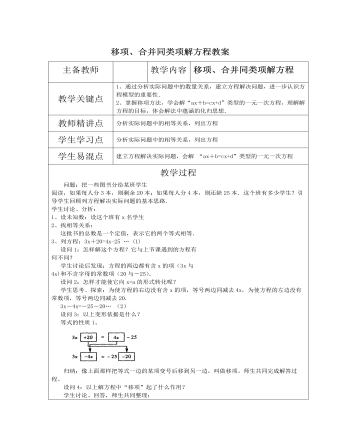
北师大初中七年级数学上册利用移项与合并同类项解一元一次方程教案2
练习:现在你能解答课本85页的习题3.1第6题吗?有一个班的同学去划船,他们算了一下,如果增加一条船,正好每条船坐6人,如果送还了一条船 ,正好每条船坐9人,问这个班共多少同学?小结提问:1、今天你又学会了解方程的哪些方法?有哪些步聚?每一步的依据是什么?2、现在你能回答前面提到的古老的代数书中的“对消”与“还原”是什么意思吗?3、今天讨论的问题中的相等关系又有何共同特点?学生思考后回答、整理:① 解方程的步骤及依据分别是:移项(等式的性质1)合并(分配律)系数化为1(等式的性质2)表示同一量的两个不同式子相等作业:1、 必做题:课本习题2、 选做题:将一块长、宽、高分别为4厘米、2厘米、3厘米的长方体橡皮泥捏成一个底面半径为2厘米的圆柱,它的高是多少?(精确到0.1厘米)
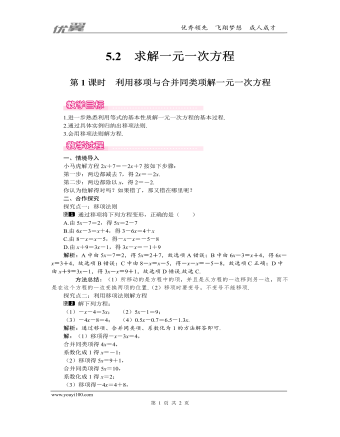
北师大初中七年级数学上册利用移项与合并同类项解一元一次方程教案1
(3)移项得-4x=4+8,合并同类项得-4x=12,系数化成1得x=-3;(4)移项得1.3x+0.5x=0.7+6.5,合并同类项得1.8x=7.2,系数化成1得x=4.方法总结:将所有含未知数的项移到方程的左边,常数项移到方程的右边,然后合并同类项,最后将未知数的系数化为1.特别注意移项要变号.探究点三:列一元一次方程解应用题把一批图书分给七年级某班的同学阅读,若每人分3本,则剩余20本,若每人分4本,则缺25本,这个班有多少学生?解析:根据实际书的数量可得相应的等量关系:3×学生数量+20=4×学生数量-25,把相关数值代入即可求解.解:设这个班有x个学生,根据题意得3x+20=4x-25,移项得3x-4x=-25-20,合并同类项得-x=-45,系数化成1得x=45.答:这个班有45人.方法总结:列方程解应用题时,应抓住题目中的“相等”、“谁比谁多多少”等表示数量关系的词语,以便从中找出合适的等量关系列方程.
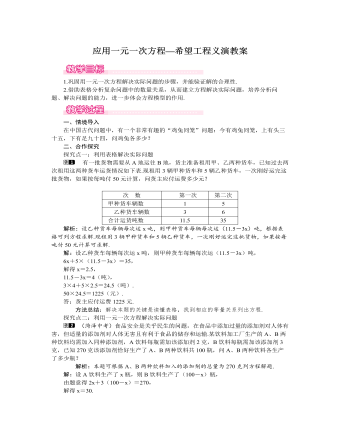
北师大初中七年级数学上册应用一元一次方程——“希望工程”义演教案1
方法总结:解题关键是要读懂题目的意思,根据题目给出的条件,找出合适的等量关系,列出方程再求解.探究点三:工程问题一个道路工程,甲队单独施工9天完成,乙队单独做24天完成.现在甲乙两队共同施工3天,因甲另有任务,剩下的工程由乙队完成,问乙队还需几天才能完成?解析:首先设乙队还需x天才能完成,由题意可得等量关系:甲队干三天的工作量+乙队干(x+3)天的工作量=1,根据等量关系列出方程,求解即可.解:设乙队还需x天才能完成,由题意得:19×3+124(3+x)=1,解得:x=13.答:乙队还需13天才能完成.方法总结:找到等量关系是解决问题的关键.本题主要考查的等量关系为:工作效率×工作时间=工作总量,当题中没有一些必须的量时,为了简便,应设其为1.三、板书设计“希望工程”义演题目特点:未知数一般有两个,等量关系也有两个解题思路:利用其中一个等量关系设未知数,利用另一个等量关系列方程
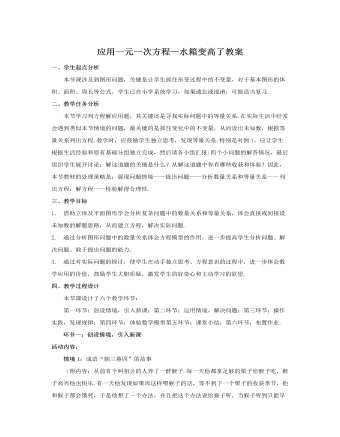
北师大初中七年级数学上册应用一元一次方程——水箱变高了教案2
从而为列方程找等量关系作了铺垫.环节2中的表格发给每个小组,为增强小组讨论结果的展示起到了较好的作用.环节3中通过让学生自己设计表格为讨论的得出起到辅助作用.2.相信学生并为学生提供充分展示自己的机会本节课的设计中,通过学生多次的动手操作活动,引导学生进行探索,使学生确实是在旧知识的基础上探求新内容,探索的过程是没有难度的任何学生都会动手操作,每个学生都有体会的过程,都有感悟的可能,这种形式让学生切身去体验问题的情景,从而进一步帮助学生理解比较复杂的问题,再把实际问题抽象成数学问题.3.注意改进的方面本节课由于构题新颖有趣,所以一开始就抓住了学生的求知欲望,课堂气氛活跃,讨论问题积极主动.但由于学生发表自己的想法较多,使得教学时间不能很好把握,导致课堂练习时间紧张,今后予以改进.
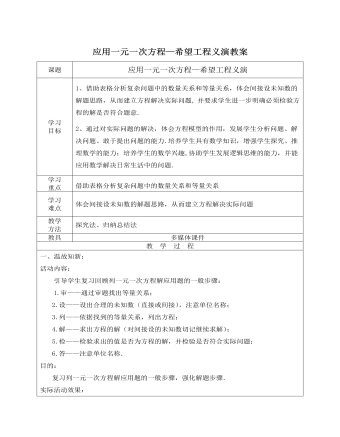
北师大初中七年级数学上册应用一元一次方程——“希望工程”义演教案2
1:甲、乙、丙三个村庄合修一条水渠,计划需要176个劳动力,由于各村人口数不等,只有按2:3:6的比例摊派才较合理,则三个村庄各派多少个劳动力?2:某校组织活动,共有100人参加,要把参加活动的人分成两组,已知第一组人数比第二组人数的2倍少8人,问这两组人数各有多少人?目的:检测学生本节课掌握知识点的情况,及时反馈学生学习中存在的问题.实际活动效果:从学生做题的情况看,大部分学生都能正确地列出方程,但其中一部分人并不能有意识地用“列表格”法来分析问题,因此,教师仍需引导他们能学会用“列表格”这个工具,有利于以后遇上复杂问题能很灵活地得到解决.六、归纳总结:活动内容:学生归纳总结本节课所学知识:1. 两个未知量,两个等量关系,如何列方程;2. 寻找中间量;3. 学会用表格分析数量间的关系.
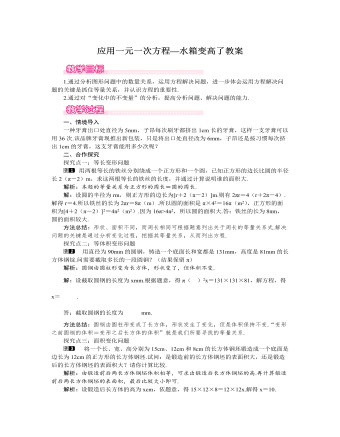
北师大初中七年级数学上册应用一元一次方程——水箱变高了教案1
解:设截取圆钢的长度为xmm.根据题意,得π(902)2x=131×131×81,解方程,得x=686.44π.答:截取圆钢的长度为686.44πmm.方法总结:圆钢由圆柱形变成了长方体,形状发生了变化,但是体积保持不变.“变形之前圆钢的体积=变形之后长方体的体积”就是我们所要寻找的等量关系.探究点三:面积变化问题将一个长、宽、高分别为15cm、12cm和8cm的长方体钢坯锻造成一个底面是边长为12cm的正方形的长方体钢坯.试问:是锻造前的长方体钢坯的表面积大,还是锻造后的长方体钢坯的表面积大?请你计算比较.解析:由锻造前后两长方体钢坯体积相等,可求出锻造后长方体钢坯的高.再计算锻造前后两长方体钢坯的表面积,最后比较大小即可.解析:设锻造后长方体的高为xcm,依题意,得15×12×8=12×12x.解得x=10.锻造前长方体钢坯的表面积为2×(15×12+15×8+12×8)=2×(180+120+96)=792(cm2),锻造后长方体钢坯的表面积为2×(12×12+12×10+12×10)=2×(144+120+120)=768(cm2).
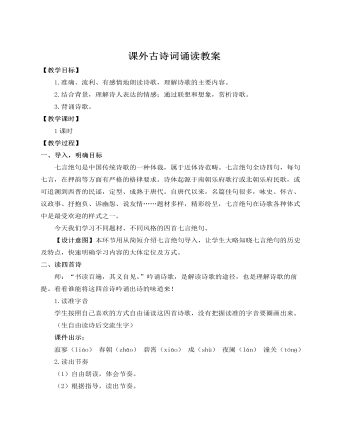
人教部编版七年级语文上册课外古诗词诵读(二)教案
材料二:锦瑟无端五十弦,一弦一柱思华年。庄生晓梦迷蝴蝶,望帝春心托杜鹃。沧海月明珠有泪,蓝田日暖玉生烟。此情可待成追忆?只是当时已惘然。(李商隐《锦瑟》)相见时难别亦难,东风无力百花残。春蚕到死丝方尽,蜡炬成灰泪始干。晓镜但愁云鬓改,夜吟应觉月光寒。蓬山此去无多路,青鸟殷勤为探看。(李商隐《无题》)材料三:《十一月四日风雨大作》(其二)作于南宋光宗绍熙三年(1192)十一月四日。陆游自南宋孝宗淳熙十六年(1189)罢官后,闲居家乡山阴农村。当时诗人已经68岁,虽然年迈,但爱国热情丝毫未减,日夜惦念报效国家,可诗人收复国土的强烈愿望,在现实中已不可能实现,于是,在一个“风雨大作”的夜里,诗人触景生情,由情生思,在梦中实现了自己金戈铁马驰骋中原的愿望。死去元知万事空,但悲不见九州同。王师北定中原日,家祭无忘告乃翁。(陆游《示儿》)材料四:清朝同治四年(1865),谭嗣同出生于北京宣武城,其父谭继洵时任湖北巡抚。光绪元年(1875),谭嗣同10岁时,拜浏阳著名学者欧阳中鹄为师。
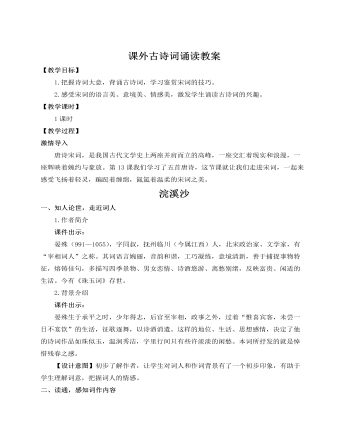
人教部编版语文八年级上册课外古诗词诵读教案
三、品读,感悟词人情怀1.品读“醉”意设问1:再次默读词作。想一想:这首词是围绕哪一个字来写的?从哪些地方可以看出来?预设 “醉”字。表现:沉醉不知归路;误入藕花深处。设问2:词人因何而“醉”?预设 因美酒和美景而“醉”。设问3:除了美景、美酒,还有什么会让李清照“醉”?预设 还有词人和自己的伙伴在一起的那种美好情谊,对年轻时那些美好生活的回忆,都让她深深陶醉。师小结:李清照的“醉”既是酒醉更是陶醉。其实不管“兴”也好,“记”也罢,“醉”也好,还是“误”也好,作者是“字字如金”。因为“兴”所以“醉”,因为“醉”所以“误”,因为“醉”,所以常常记得。2.品字悟情设问1:如何理解两个“争渡”表达出的情感?预设 两个“争渡”,表现了主人公急于从迷途中找寻出路的焦灼心情。正是由于“争渡”,所以又“惊起一滩鸥鹭”,把停栖在沙洲上的水鸟都吓飞了。至此,词戛然而止,言尽而意未尽,耐人寻味。



